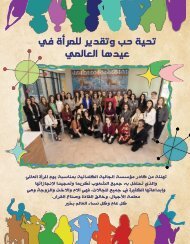Create successful ePaper yourself
Turn your PDF publications into a flip-book with our unique Google optimized e-Paper software.
CHALDEAN STORY<br />
We are pleased to present the first installment<br />
of a new year-long “Chaldean Story”<br />
series, made possible by a generous grant<br />
from Michigan Humanities’ Great Michigan<br />
Stories program. The grant allows us to fully<br />
explore the stories of Chaldean immigrants<br />
to Michigan, who have brought with them<br />
an ancient culture that has been carefully<br />
and lovingly preserved in story and art.<br />
Through feature stories, podcasts, and<br />
events planned for the next 12 months, we<br />
aim to tell the story of Michigan’s Chaldean<br />
community, and the contributions they’ve<br />
made to our state. As of <strong>2023</strong>, more than<br />
160,000 Chaldeans call Michigan home.<br />
Chaldean<br />
Cultural<br />
Roots<br />
Innovations that<br />
shaped civilization<br />
BY SARAH KITTLE<br />
Where did Chaldean culture start? Chaldeans,<br />
Assyrians, and Syriacs – whatever<br />
they call themselves – are the descendants<br />
of ancient Mesopotamians, with a rich cultural<br />
history to be proud of.<br />
Mesopotamia, referred to as the “Cradle of Civilization,”<br />
was home to some of the earliest complex<br />
societies in human history. Located in the region of<br />
the Tigris and Euphrates rivers, it was the birthplace<br />
of many remarkable advancements that laid the<br />
foundation for future civilizations. Ancient Chaldean<br />
history is a part of Mesopotamia; its people<br />
kicked off a dynasty that would later be known as<br />
the Neo-Babylonian Empire.<br />
Most of us are aware that the wheel was invented<br />
in Sumer sometime in the fourth millennium BC.<br />
Originally used by potters to help shape clay, the<br />
invention led to use on carts and battle chariots<br />
as well as agricultural tools and mechanisms. But<br />
there are many other “firsts” to celebrate.<br />
Among the many inventions credited to Mesopotamian<br />
cultures, most notably the Sumerians, are<br />
the first written language, first code of law, first urbanization<br />
in the form of city-states, first astronomical<br />
calendar, and first numerical system based on<br />
60 (seconds in a minute, minutes in an hour). They<br />
also invented the idea of a 24-hour day and the concept<br />
of zero!<br />
Through chronicles of entrepreneurship,<br />
culture, and spirituality, we will tell<br />
stories of brave deeds, endless resiliency,<br />
and epic generosity, as remembered by<br />
those who witnessed these acts. We will<br />
explore the Chaldean immigrants’ path<br />
from party stores to boardrooms and will<br />
share their deep and abiding faith in God<br />
and their strong commitment to family.<br />
Everything that we have celebrated for<br />
nearly two decades will be highlighted in<br />
this series, which gives us a chance to follow<br />
the narrative from the beginning—the<br />
emigration from Iraq, through the journey to<br />
get here, to the present. We hope you enjoy<br />
reading it as much as we enjoy writing it.<br />
Cuneiform Writing<br />
Arguably the most significant Mesopotamian first<br />
was the invention of writing. Sometime around midmillennial<br />
3000 BCE, Sumerians—people of southern<br />
Mesopotamia whose civilization flourished during<br />
that era—devised cuneiform script, a complex<br />
system using wedge-shaped marks. Written on clay<br />
tablets and initially used for record-keeping, cuneiform<br />
gradually evolved into a sophisticated writing<br />
system encompassing literature, mathematics, astronomy,<br />
and law.<br />
The hundreds of thousands of texts discovered<br />
over the years by archeologists include royal<br />
inscription and treaties as well as everyday bookkeeping.<br />
Extensive libraries were kept in temples<br />
and palaces, and King Shulgi of Ur (ruled 2094-2047<br />
BC) and Ashurbanipal of Assyria (ruled 668-627 BC)<br />
each made the claim to be able to read and write ancient<br />
cuneiform. Aramaic became intertwined with<br />
Akkadian during the reign of the Assyrian empire,<br />
and by the time Ashurbanipal was king, Aramaic<br />
spread throughout the Assyrian empire.<br />
The invention of written language not only<br />
transformed communication but also paved the way<br />
for the transmission and preservation of knowledge<br />
across generations. It was a pivotal moment in human<br />
history; cuneiform became the precursor to all<br />
subsequent writing systems.<br />
Code of Law<br />
Mesopotamia introduced the world to the concept<br />
of law and established legal systems. They also<br />
witnessed the earliest known legal code, known as<br />
the Code of Hammurabi. Created by the Babylonian<br />
king Hammurabi around 1754 BCE, this comprehensive<br />
set of laws covered various aspects of life, including<br />
commerce, family, and property rights.<br />
Hammurabi expanded the city-state of Babylon<br />
26 CHALDEAN NEWS <strong>AUGUST</strong> <strong>2023</strong>

















